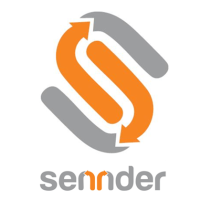
The logistics industry is regarded as highly inefficient. This extends from legacy systems and processes that still rely heavily on manual inputs and intuition-based decisions to the slow adoption of digital innovations compared to other industries. However, digital transformation is engulfing the logistics industry, enabled through the entrance of new digital start-ups, such as digital forwarders.
Similar to traditional forwarders, digital forwarders act as intermediaries in the transportation process and take on execution and pricing risk. They are the contractual partner and single point of contact for both the carriers and the shippers. The difference is that digital forwarders’ core offering is leveraging technology to tackle shippers’ pain points and automate processes, optimise asset utilisation and provide increased asset visibility.
One of the fastest growing digital forwarders on the European road freight market is the Berlin-based start-up sennder. sennder was founded in 2015 and has raised over €100m in funding after five rounds of investments. It connects large shippers with carriers, taking on responsibility for the execution of the transport operations.
The company offers a broad range of services, including express deliveries, e-commerce logistics, special needs loads and refrigerated shipments. However, its focus is on contract-based, long-haul FTL shipments and it is this close focus on FTL that has enabled it to grow so rapidly over such a short period of time. Shippers can integrate their systems with sennder’s IT platform, allowing them to more conveniently book trucks via API and receive instant pricing and live cargo data. Its clients include the leading e-commerce platforms in Europe.
sennder has managed to build up its scale significantly since its establishment and has on-boarded over 7,500 carriers into its network, aiming to double this number in 2019. The start-up emphasises that it has grown to become the largest customer of many carriers in its network due to the constant loads it guarantees to its carriers. This makes carriers more willing to digitalise their processes which underpins sennder’s service offering. Another seemingly effective and increasingly common incentive to get carriers on board is faster payment. The average time to receive payment in the road freight market is estimated at 60 days, which often leads to cash-flow problems for carriers. To tackle this issue sennder has started offering payments to carriers within a few days after the shipment has been completed.
In 2017, sennder entered a partnership with Scania, a leading manufacturer of trucks and buses for heavy transport applications. This partnership was formed after a seven-digit investment by the truck manufacturer in the start-up, which not only gives sennder more credibility in the market but is also used to support the in-house software development and digitization of the transport processes. Through this close cooperation, sennder offers Scania drivers and other on-boarded carriers its own driver apps, fleet management tools, instant price information as well as individual reports and automated notifications.
To get a better understanding of sennder’s business model, Ti spoke with David Nothacker, Co-Founder and Managing Director at sennder. One of the key insights highlighted was the hesitance towards adopting technologies within the road freight market. Nothacker stated that “The big problem is not developing the technology; it’s pushing the adoption of technology with carriers or customers (shippers).” Technologies such as TMS, telematics, visibility platforms, digital tendering, AI driven load-matching optimization or instant data sharing are already available in the market and continuously improved. However, as explained by Nothacker, the level of adoption of these technologies by forwarders, carriers and shippers is still moderate.
As a first step toward full digitalization, forwarders must automate and digitalise their own internal operations, argued Nothacker. Acting as the middleman between shippers and carriers, they are in the optimal position to steer the industry away from manual processes and improve efficiency through digitalization. Digital forwarders are enabling this through their technology-centric approach to forwarding. Some traditional forwarders, including DHL, UPS, DB Schenker and GEFCO, have also invested in new digital start-ups, generated internal spin offs or separately branded business units to compete with digital forwarders and offer similar digital solutions.
The second step is to digitalise carriers’ operations. Many digital forwarders and Software as a Service (SaaS) companies are now focusing on on-boarding carriers and guiding them through the digitalization trend. Digital forwarders promise additional business and automation for carriers and introduce new software and IoT devices, often radically changing and digitalizing the carriers’ business processes. Some digital forwarders provide carriers with additional incentives to encourage technology adoption. These include fuel cuts, insurance, fleet management systems, cheaper tire retreading, easier access to new and second-hand trucks, break-down assistance, etc.
The third step in the digital transformation is the digitalization of shippers. Very often, big shippers don’t have systems with open APIs or have very old systems, making the integration with digital freight forwarding platforms very difficult. In addition to this, the existing culture within the logistics industry has often stifled collaboration and open data sharing between forwarders and shippers. This makes shippers hesitant to open up their systems and share information about internal operations with digital forwarders and carriers.
Looking at how the digital logistics market landscape is evolving, it will be interesting to see how sennder and other digital forwarders continue to further digitalise, not just their internal processes but those of carriers and shippers and if the increased level of technology adoption will also open the market even further to new digital entrants.
Source: Transport Intelligence, November 13, 2019
Author: Sergio Korchoff